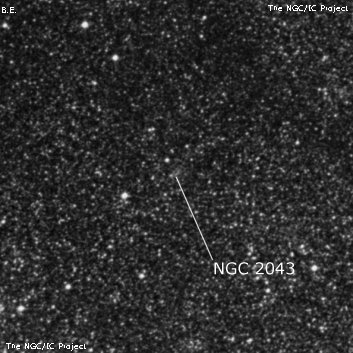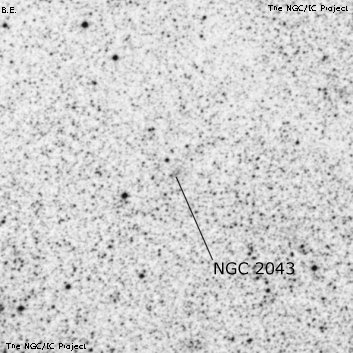NGC/IC Project Restoration Effort
(This is a very very beta version)
NGC2043


Basic Information
Location and Magnitude
Right Ascension: 5:35:57.3
Declination: -70:4:28
Constellation: MEN
Visual Magnitude:
Historic Information
Discoverer: Baracchi
Year of discovery: 1884
Discovery aperture: 48.0
Observational
Summary description: S, E group of F st inv in F neby
Sub-type: OCL
Corwin's Notes
=====
NGC 2043 is probably = NGC 2036. This was found in December of 1884 by Pietro
Baracchi with the Great Melbourne Telescpe. He has this to say about it:
"Preceding H.1259 [sic; = GC 1259 = NGC 2058] by 79.5s and 4 [arcmin] 30
[arcsec] north is a small elongated group of minute stars involved in very
thin nebula ..." (he goes on to describe NGC 2072, which see, another of his
discoveries in the area).
Given the position of NGC 2058, we should find NGC 2043 at 05 36 07.0,
-70 06 48 for 1950. There is nothing exactly there but very faint field stars
in the LMC, but 2.5 arcmin south-southwest is a linear asterism 1.7 x 0.5
arcmin, perhaps part of a star cloud (more below), that fits Baracchi's
description.
After I wrote that, Steve Gottlieb pointed out that Jenni Kay has suggested
that NGC 2043 = NGC 2036. This would require a one minute error in the RA of
of N2043, but N2036 would match Baracchi's description very well. If, as
Steve himself suggested, Baracchi thought that NGC 2036 was a degree north of
its actual position, then he would have taken the cluster as a "nova". But
JH's italicized note for NGC 2036 stands out quite well in CGH, so I don't see
how Baracchi could have missed it. Perhaps he was working from GC only; if
so, he would have had no clue that JH had written that the NPD of N2036 might
be a degree off. Baracchi would, therefore, have believed that N2043 was
indeed a new discovery.
NGC 2043 is almost certainly not the very faint cluster that ESO chose, and I
doubt that it is the vague collection of stars marked in the Hodge-Wright
Atlas, either. Going through that Atlas many years ago, I had marked the
small star cloud containing the north-south line of stars (that I mentioned
above) as a candidate for the NGC number. I've retained the position for that
in the table as well as the linear asterism itself.
Finally, there is a curiosity in the Melbourne observations. Baracchi also
describes another "new" nebula in the LMC at 05 37 17, -70 08.4 (1950) as "an
extremely faint, flat, a little [sic] elongated patch, not shown by any of the
previous observers. It precedes H. 1260 [sic; = GC 1260 = NGC 2059] by 14s,
and is 1 [arcmin] North of it" in the text, and "Very, very faint, flat,
elongated, small, indistinct," in his table of transit times. The difference
in RA in the table is 13.9 seconds, consistent with the text. As with NGC
2043, there is nothing exactly at this position, but there is an asterism of
6-8 LMC stars at 05 37 23.5, -70 08 12 (1950). The curiosity is that this
object is not listed in the NGC. I discuss it further in the "notngc" files.



